
Perfume Creation Behind the Scenes: The Fascinating Process from Concept to Shelf
Perfume Creation is a magical process that takes an idea and turns it into a fragrant work of art that can be found in perfumeries all over the world as we explore the fascinating world of perfumery and learn about the tricks and skills that make scents come to life.
The Perfume Creation Process Unveiled
Making a perfume is like writing a symphony—many notes and parts must work together to create a beautiful smell. Here's a glimpse into the intriguing steps that led to the birth of a perfume:
Conceptualization
The journey begins with a concept—a vision of the fragrance's character, the emotions it should evoke, and its intended audience. Perfumers draw inspiration from diverse sources, from nature to personal experiences, to give life to their ideas.
Selection of Ingredients
What makes a perfume work is what it's made of. The essential oils, extracts, and aroma compounds that make up a smell are carefully chosen by perfumers. The fragrance's smell, duration, and general personality depend on the ingredients used.
Blending and Formulation
Perfume creation is a delicate dance of blending ingredients. Perfumers, known as "noses," combine various aromatic elements, experimenting with different ratios until the desired scent profile emerges. This stage demands precision and a keen sense of smell.
Aging and Maturation
After being mixed, the perfume goes through a process called maturing. It's like letting a fine wine age; as the smell ages, its different notes blend together. This step could last for a few weeks to a few months.
Quality Testing
Quality control is essential when making cologne. Perfumers use harsh tests to make sure that scents are consistent, last a long time, and stay stable. They test the smell in different settings to make sure it's the best it can be.
Bottling and Packaging
The end product is carefully put into bottles and boxes. Fragrances often spend a lot of money on beautiful boxes that match the luxury and craft of the scent. The bottle design and labels are very important for getting across the essence of the perfume.
The Art of Perfume Blending
The mixing process is one of the most exciting parts of making perfume. Different methods are used by perfumers to create the right scent:
- Layering: Layers of ingredients are added one at a time, giving each note a chance to shine before mixing with others.
- Maceration: To get the essence of an ingredient, it is soaked in a liquid. A lot of the time, this method is used for botanical products.
- Fractionation: Separating essential oils into fractions to isolate specific scents enhancing precision in blending.
- Distillation: Steam distillation extracts essential oils from plant materials, preserving their aromatic properties.

Essential Oils in Perfumery: Building Blocks of Fragrance
Essential oils are what make perfumes work. Natural things like flowers, herbs, spices, and woods make these powerful liquids. They give each scent depth, complexity, and a unique quality. Rose, lavender, patchouli, and sandalwood are some of the most common essential oils used in fragrance.
Perfume Business and Marketing: Scenting Success
Making a perfume doesn't stop with the formula; it includes business and marketing. There are different ways that perfume houses get their products on the market, such as:
- Branding: Building a distinct brand identity that resonates with consumers.
- Marketing Campaigns: Crafting compelling stories around each perfume to entice customers.
- Retailing Tactics: Strategically placing perfumes in stores and online platforms.
Perfume Industry Insights: Trends and Preferences
The perfume business is always changing because people's tastes are always changing, and people are worried about the environment. For perfume houses to stay current, they need to know what the market trends are. Clean and eco-friendly smells, personalized scents, and the mixing of technology and perfumery are some of the latest trends.
A Scented Odyssey: Perfume and Cultural Influences
It's not just about the smell of perfume; it's also a record of culture and history. People from different countries have their own favorite smells and memories that go with them. Perfumes are often culturally significant, which makes them a link between the past and the present.
Decoding the Perfume Creation Myth
Perfume creation has its share of myths and misconceptions. Perfumers and fragrance enthusiasts often encounter these myths as they explore the world of scents. It's essential to separate fact from fiction to truly appreciate the art and science of perfumery.
The Fragrant Intersection of Science and Art
The process of making perfume shows how science and art can live together peacefully. It takes the science of smell molecules and the artistic sense of perfumers and puts them together. Every perfume bottle is a mix of science and art, which is what this skill is all about.
As we come to the end of this tour of the perfume-making process, it's clear that making perfume is a labor of love, an artistic expression, and a physical adventure. Every step of the process is filled with love and care, from the first idea to the finished shelf. It shows how fragrances have always been appealing—a world where science, art, and feeling come together to give us beautiful scents that change our lives in many ways.

Explore the exquisite Asēdos perfume oil collection:
Get Social:

